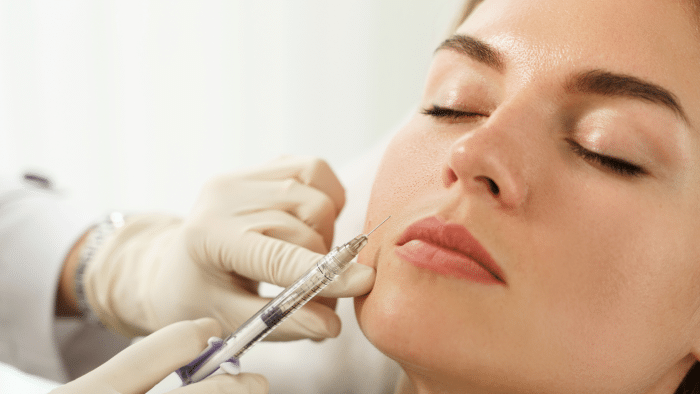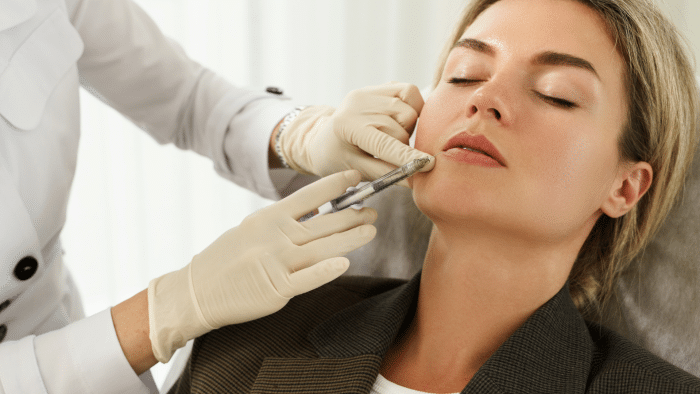
Studies have discovered that the levels of collagen and elastin in the human body decrease with age, causing the skin to lose its firmness and produce a drooping appearance. One of the most common aesthetic concerns with sagging skin is the jowls, which can affect nearly everyone.
Fortunately, Juvederm emerges as a frontrunner in non-surgical facial rejuvenation. Once injected beneath the skin, it instantly restores facial contours and volume, making Juvederm a top solution for jowls.
In this article, we will explore the transformative effects of Juvederm fillers on the jowl area.
Key Takeaways
- Juvederm fillers are a practical option for restoring facial contours and addressing jowls.
- Understanding the science behind jowl formation, including the impact of aging on facial structure, volume loss, and skin laxity, is crucial for successful treatment.
- Juvederm fillers offer specific properties that make them suitable for jowl rejuvenation, providing lift and support to sagging tissues.
- Injection techniques, dosing considerations, and patient selection criteria significantly achieve optimal outcomes with Juvederm fillers.
About: Doctor Medica is your trusted supplier of top-quality dermal fillers, viscosupplements, and more for your medical practice. We offer genuine products from leading brands at the lowest prices. Contact Doctor Medica today if you want to buy Juvederm wholesale for your practice.
The Science Behind Jowl Formation

Aging changes every part of the face. This process affects volume, where fat sits, and deep parts of the face. Because of aging, soft tissue gets less plump over time. Also, fat moves around.
Volume loss and skin laxity play critical roles in facial aging, leading to the formation of jowls. As people age, their faces lose volume, especially around the jawline and mid-face area.
Introducing Juvederm Fillers for Jowl Rejuvenation
Juvederm stands out because it mixes well with the body’s hyaluronic acid. This mixing helps make facial contours look better and smooths out wrinkles. They are special because Juvederm Volux XC is the only filler approved by the FDA to improve the jawline’s look, showing results that last a long time.
Juvederm fillers offer many benefits for those looking to enhance their facial contours, delivering versatility in addressing different concerns. While some doctors use Juvederm for the under-eyes, they also utilize these powerful fillers to address jowls. Specifically, Juvederm Volux helps soften jowls and lessen the look of a double chin, while Juvederm Voluma tightens skin and fades deeper expression lines.
The process is affordable and comes with minimal downtime—patients can see improvements quickly without surgery. Patients appreciate the reduced pain and quick return to daily activities. These treatments improve looks and help people feel better about their appearance.
Injection Techniques and Dosing Considerations

Juvederm fillers work wonders on jowls by restoring facial contours. Doctors often choose specific spots for these injections to get the best results. The orbital, cheek, nasolabial, and temporal regions are vital places. These areas can lose volume or become wrinkly with age. Injecting Juvederm here helps lift and smooth the skin.
For jowl rejuvenation, getting the dose right matters a lot. Too much filler can make the chin look wide and mess with the face’s balance. A good rule is to start small and add more if needed.
Patient Selection Criteria for Optimal Outcomes
Doctors must examine each patient’s face structure and skin to select suitable candidates for Juvederm filler treatments: good skin quality and a solid ability to make collagen mean better results after treatment.
Managing patient expectations is critical to getting good results with Juvederm filler for jowls. Doctors need to talk clearly with patients about what the treatment can and cannot do.
It’s all about being honest and setting realistic goals from the start. Patients often have high hopes for their looks after treatment. So, doctors must explain how facial anatomy, aging, and skin quality affect outcomes.
Future Trends in Jowl Rejuvenation

Juvederm fillers shine a hopeful light on the future of dealing with jowls. They bring back lost facial shapes and smooth out sagging skin. New techniques improve each year at giving faces a fresh, youthful look.
People love seeing how young they feel inside; their reflections match that. So here’s to more smiles in the mirror—Juvederm is leading the way in ensuring faces keep telling happy stories.
Conclusion
Restoring facial contours with Juvederm filler for jowls brings back a youthful look. This treatment is like giving your face a soft, natural lift without surgery. Many find their confidence boosted after seeing the smoother jawline and reduced sagging.
With technology advancing, who knows what new improvements we’ll see next in facial rejuvenation? Juvederm has set the bar high by blending science and aesthetics to redefine beauty standards.
FAQs
1. What is Juvederm filler?
Juvederm filler is a gel that doctors put under your skin to make wrinkles and folds look smoother.
2. Can Juvederm filler fix my jowls?
Yes, it can help lift and smooth out the area around your jowls, making them less noticeable.
3. How long does the treatment take?
The whole process usually takes about 30 minutes.
4. Will getting Juvederm filler hurt?
You might feel a little pinch or discomfort, but it’s generally not too bad.
5. How long will the results last?
The smooth look you get from Juvederm can last up to two years.
References
Jewell T. Jowls: Why it happens and what you can do. Healthline. Published November 16, 2023. https://www.healthline.com/health/beauty-skin-care/jowls
Kapoor, K. M., Saputra, D. I., Porter, C. E., Colucci, L., Stone, C., Brenninkmeijer, E. E. A., Sloane, J., Sayed, K., Winaya, K. K., & Bertossi, D. (2021). Treating Aging Changes of Facial Anatomical Layers with Hyaluronic Acid Fillers. Clinical, cosmetic and investigational dermatology, 14, 1105–1118. https://doi.org/10.2147/CCID.S294812
Farkas, J. P., Pessa, J. E., Hubbard, B., & Rohrich, R. J. (2013). The Science and Theory behind Facial Aging. Plastic and reconstructive surgery. Global open, 1(1), e8-e15. https://doi.org/10.1097/GOX.0b013e31828ed1da
Related Articles
Joanna Carr
About Intraline PDO Threads – Excellent Safety Profile and Virtually Non-Allergenic
Discover why Intraline PDO threads are favored in aesthetic medicine for their excellent safety profile, minimal allergenic risk, and effectiveness in...
Joanna Carr
Managing Complications with HYAcorp Fillers: A Professional Guide
Discover a professional guide to managing complications with HYAcorp fillers. Learn essential strategies, best practices, and safety protocols to ensu...
Joanna Carr
Exploring the Efficacy of an Orthovisc Injection in Knee Joint Pain Management
Interested to learn more about Exploring the Efficacy of an Orthovisc Injection in Knee Joint Pain Management? Browse Doctor Medica's comprehensive li...


